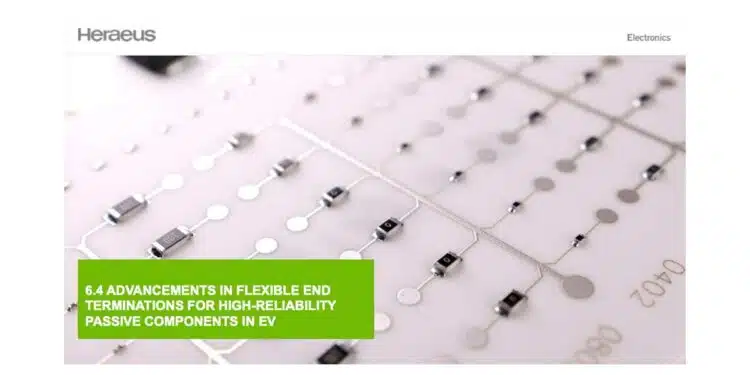The paper “Advancements in Flexible End Terminations for High-Reliability Passive Components in Electrified Vehicle” was presented by Dean Buzby, Heraeus Electronics, West Conshohocken, Pennsylvania, USA at the 5th PCNS Passive Components Networking Symposium 9-12th September 2025, Seville, Spain as paper No. 6.4.
Introduction
The rapid electrification of the automotive industry is reshaping the landscape of electronic component requirements.
Electric vehicles (EVs) demand a significantly higher number of multilayer ceramic capacitors (MLCCs), often exceeding 15,000 per vehicle, compared to only 2,000–3,000 in traditional internal combustion engine (ICE) vehicles.
This surge in demand is driven by the increasing complexity of electronic subsystems such as battery management systems, high-voltage inverters, heads-up displays, and radar units. With this growth comes the heightened importance of reliability, as component failure in these safety-critical systems can have serious consequences.
Key Points
- EVs require up to 10 times more MLCCs than ICE vehicles, amplifying the need for high-reliability components.
- Mechanical cracking due to board flexure is the primary failure mode for MLCCs.
- Traditional thermoset epoxy-based flexible terminations face limitations, including cold storage requirements, high silver content, and short shelf life.
- A new thermoplastic-based flexible termination ink developed by Heraeus Electronics offers enhanced mechanical durability, room temperature stability, and cost efficiency.
- Performance testing demonstrates superior flex tolerance, electrical stability, and ease of integration into current manufacturing processes.
Extended Summary
The transition to electrified transportation is creating unprecedented demand for passive components that are both reliable and cost-effective. The shift to EVs introduces challenges such as increased susceptibility to mechanical stress, thermal cycling, and vibrations, which collectively heighten the risk of MLCC failures. Mechanical cracking, primarily caused by printed circuit board flexure, remains the most common and critical failure mechanism. These cracks can degrade performance, lead to leakage currents, and in severe cases, cause short circuits that jeopardize vehicle safety.
Conventional flexible terminations, typically made from thermoset epoxy materials, have long been used to mitigate the risk of cracking. While these materials provide some mechanical cushioning, they present notable operational and logistical challenges. They require refrigerated storage, have limited shelf life once thawed, and contain high levels of silver, increasing both cost and environmental burden. Additionally, the production process is complex and can result in material waste.
Heraeus Electronics has introduced an innovative flexible termination ink based on high-temperature thermoplastic polymer chemistry. This formulation significantly improves upon conventional solutions by delivering superior mechanical performance, withstanding board flexes of up to 10 mm without cracking—twice the industry benchmark. Components using this technology also maintain electrical stability, with less than 3% capacitance deviation even under mechanical stress.
The new thermoplastic-based terminations offer notable logistical benefits. They remain stable at room temperature for up to six months, eliminating the need for cold-chain logistics and simplifying inventory management. Lower silver content reduces material costs by 5–10%, and the extended shelf life further minimizes waste. These factors collectively enhance cost efficiency and sustainability.
Comprehensive validation testing in line with AEC-Q200-005 standards confirms the reliability of these materials. Flex tests revealed no cracking or electrical degradation, while adhesion tests demonstrated robust bonding without delamination. The surface finish remains smooth and compatible with nickel/tin plating, ensuring seamless integration into existing manufacturing lines. The curing process is compatible with standard production parameters, requiring only moderate drying and curing stages.
By addressing mechanical durability, storage stability, cost, and process compatibility, these thermoplastic-based end terminations represent a major advancement for high-reliability automotive components.
Conclusion
The evolution from traditional thermoset epoxy terminations to thermoplastic-based alternatives marks a pivotal advancement for the electronics industry supporting EVs. These materials deliver improved mechanical and electrical performance, reduced cost, and simplified logistics, all while aligning with stringent automotive reliability standards. As the automotive sector continues to scale electrification, these innovations will help ensure that component reliability and manufacturing efficiency advance in tandem, supporting the next generation of high-reliability automotive electronics.
Read the complete white paper:
For in-depth details see complete Heraeus Electronics’ white paper:






























